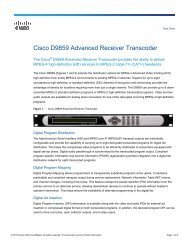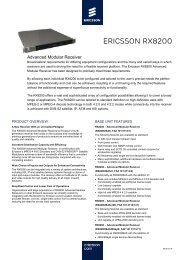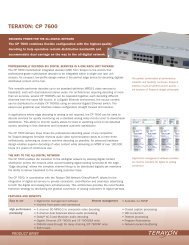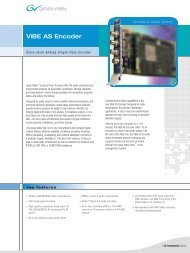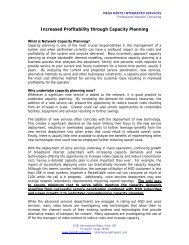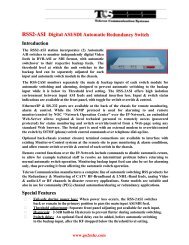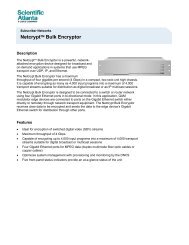Cisco ONS 15454 M6 Multiservice Transport Platform - Mega Hertz
Cisco ONS 15454 M6 Multiservice Transport Platform - Mega Hertz
Cisco ONS 15454 M6 Multiservice Transport Platform - Mega Hertz
You also want an ePaper? Increase the reach of your titles
YUMPU automatically turns print PDFs into web optimized ePapers that Google loves.
Data SheetFigure 3.Electrical Connection UnitThe <strong>Cisco</strong> <strong>ONS</strong> <strong>15454</strong> <strong>M6</strong> MSTP platform provides capital and operational efficiency by addressing the increasingdemand for bandwidth and multiple services at the edge of the network. It uses the existing <strong>Cisco</strong> <strong>Transport</strong>Controller management and integrates well with other optical transport platforms. With innovative technology, the<strong>Cisco</strong> <strong>ONS</strong> <strong>15454</strong> <strong>M6</strong> MSTP pushes intelligence to the edge of the network, thus allowing the optimization of nextgenerationnetworks across multiple layers and removing costly optical-electrical-optical (OEO) devices for networksegmentation or regeneration.The <strong>Cisco</strong> <strong>ONS</strong> <strong>15454</strong> <strong>M6</strong> MSTP carries on the existing features such as multilayer graphical network, node, andcard visibility; A-to-Z network-based service provisioning; and graphical software wizards to simplify and speed useroperations for such tasks as initial network turn-up; service provisioning; and network, node, and bandwidthupgrades. The <strong>Cisco</strong> <strong>ONS</strong> <strong>15454</strong> <strong>M6</strong> MSTP takes advantage of the embedded software architecture and controlplane to introduce a level of operational simplicity unheard of in DWDM networks.In addition to the integrated software features, the <strong>Cisco</strong> <strong>ONS</strong> <strong>15454</strong> <strong>M6</strong> MSTP is supported by an easy-to-use butpowerful network design tool, the <strong>Cisco</strong> <strong>Transport</strong> Planner. This tool is a user-friendly, Java-based application (fullydeveloped and tested by <strong>Cisco</strong>) for modeling and optimizing DWDM networks based on the user’s networkparameters.Topology FlexibilityOne recent core network trend is the consolidation of multiple Layer 2/3 networks into a single IP/Multiprotocol LabelSwitching (IP/MPLS) infrastructure. In spite of this Layer 2/3 convergence, however, the underlying transport layer(Layer 1) of many service provider core networks has continued to use SONET/SDH. Many service providernetworks globally still use SONET/SDH, creating OpEx and CapEx concerns for service providers as well as thechallenges of profitability and return on investment (ROI). Some network inefficiencies result from the way coretransport networks are built out today to support the IP or service layer over the SONET/SDH layer, supported by anunderlying DWDM infrastructure. The OEO conversions and the associated electrical processing directed by thelayered network architecture result in an additional cost in terms of space, because many racks of shelves may berequired in a service provider point of presence (POP), as well as additional power and cooling that is necessarybecause of the active electronics components that they contain.You can configure the <strong>Cisco</strong> <strong>ONS</strong> <strong>15454</strong>, <strong>ONS</strong> <strong>15454</strong> <strong>M6</strong>, and <strong>ONS</strong> <strong>15454</strong> M2 MSTP chassis to support any edge,metro, regional, or core DWDM topology, allowing you to use a unified solution for the overall network, independentlyfrom the topology and reach. The ultimate topology flexibility is achieved through a set of fully reconfigurable opticaladd/drop multiplexers (ROADMs). Multidegree ROADMs (2 through 8 degrees of freedom) allow wavelengths toremain in the optical domain while being passed from one ring or network segment to another, further eliminating theneed for OEO conversions and using the ability of core routers to initiate DWDM-compatible wavelengths.The <strong>Cisco</strong> <strong>ONS</strong> <strong>15454</strong> <strong>M6</strong> MSTP with the single-module ROADM offers a tremendous decrease in footprint, powerrequirements, and patch-cable complexity over the first-generation ROADMs.© 2011 <strong>Cisco</strong> and/or its affiliates. All rights reserved. This document is <strong>Cisco</strong> Public Information. Page 3 of 7



